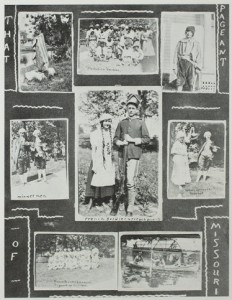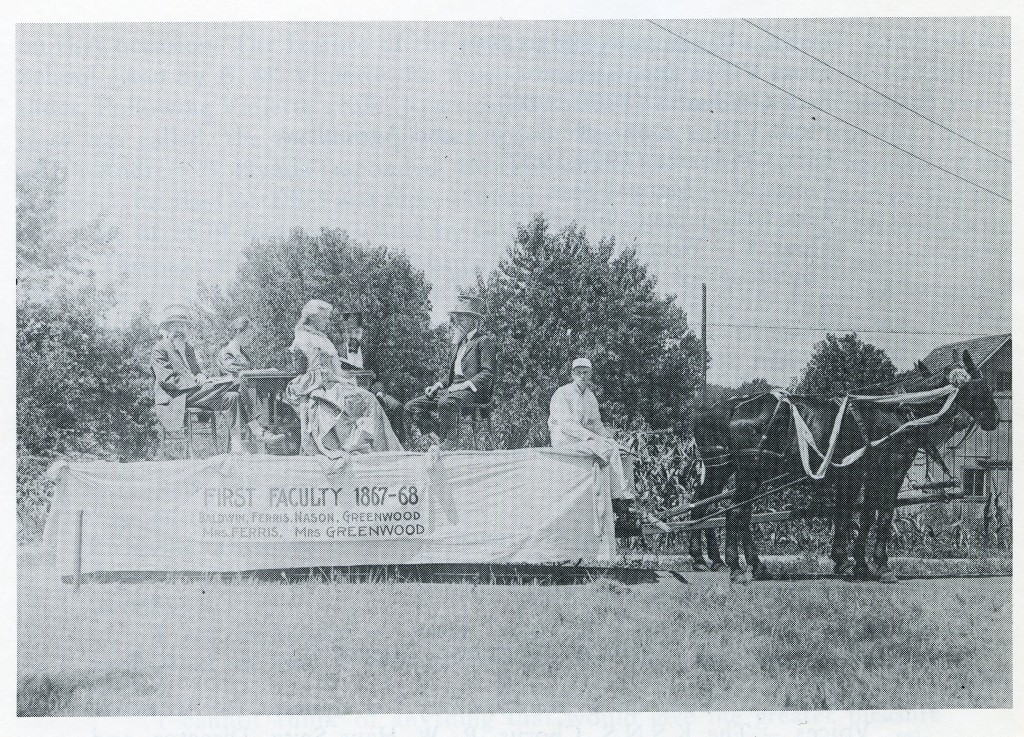Times of Celebration
Despite the ongoing conflict in Europe, residents of Kirksville found ways to celebrate and support their community. A great pageant was held to honor the great civilizations of history. A two-day festivity-filled centennial celebration took place to honor the fifty-year anniversary of the Normal School. And the greatest celebration of all occured on November 11, 1918.
The Pageant of Nations
In May of 1916, the K.S.N.S. held the “Pageant of Missouri”, a program dedicated to the cultural history of Missouri. The pageant was such a success, the college decided to put on an even grander display of heritage and history in the spring of 1917. However, because of the flat terrain in the seating area for the “Pageant of Missouri”, a new outdoor amphitheater had to be built to allow audience members to see over the heads in front of them. The new amphitheater seated three thousand people and cleared the way for the pageant planning to begin. 1
Professor E. M. Violette (the same E. M. Violette who later collected the Great War letters digitized on this website) served as the committee chairman and master of ceremonies. Thurba Fidler, Meta Gill, Louise Kirkham, Grace Lyle, Lena Patterson, R.W. Hans Seitz, and Flora Snowden assisted E. M. Violette. Grace Lyle designed the costumes; Lena Patterson designed the scenery along with the Fine Arts Department. Flora Snowden supervised the creation of the costumes. Members of the English and Physical Education Departments collaborated and coached the pageant performances. Johannes Goetze composed the music. More than anything, the committee strove to present a dramatization that revealed the development of civilizations with what the committee saw as complete historical accuracy. The costumes were crafted with great historical detail, and Goetze selected appropriate and period-accurate music to accompany the performances.2
Considering the ongoing war in Europe, it is interesting to note that the committee selected the theme of the pageant to be the evolution of the civilization of man, calling it the “Pageant of Nations.”3 The pageant was organized into prophecies, interludes, and episodes, with the episodes connected by symbolic interludes. The episodes of the pageant presented the historically accurate portrayals of Egypt, Palestine, Greece, Rome, Medieval Europe, Modern Europe, and America.
Six hundred individuals from the K.S.N.S. participated in the “Pageant of Nations” on Friday, May 18, 1917. Attendees claimed that the audience broke all attendance records held by the Normal School. This would be the last pageant of this kind held by the K.S.N.S. With the War Declaration in April, the college did not have time to direct another grand pageant; instead, students and faculty focused their energy on the war effort.4
The Semi-Centennial Celebration:
Held from August 2-3 in 1917, just a few months after the United States joined the war in Europe, the Semi-Centennial Celebration commemorated fifty years of the Normal School in Kirksville. The celebration had multiple goals; the Normal School sought to recognize the growth and subsequent development of the college, to commemorate the efforts of the founders of the school, and to allow students and alumni to rekindle old friendships and forge new ones.5
At the main assembly for the celebration, a letter from General John J. Pershing was read before the crowd. Pershing, a Normal School alumnus and commander of the American Expeditionary Force in France, would be awarded the rank of “General of the Armies of the United States” in 1919. General Pershing and George Washington are the only two individuals to ever receive this honor.6
Paris, France, July 13, 1917
P.O. Selby, Registrar
First District Normal School
Kirksville, MissouriDear Sir:
I am in receipt of your letter of June 25th, relative to the celebration of the fiftieth anniversary of the First District Normal School.
I cannot think of anything that would give me greater pleasure than to be present at the reunion of students on this occasion. The school days that I spent in Kirksville Normal School are full of many pleasant memories. Please extend to the students and graduates my very warm regards and accept my very best wishes for the continued prosperity of the institution.
I hope to receive a full report of the reunion.
JNO. J. PERSHING (3-6)7
The celebration also featured a grand parade, productions, and a touching ceremony where students and alumni decorated the graves of deceased faculty members. Festivities concluded Friday with a production of Shakespeare’s King Lear in a large open air theater. King Lear was played by Glen James; Cordelia by Mary Perrin; The Fool by Lawson Wise; and the Duke of Gloucester by P. A. Delaney. 8
Armistice:
News of the armistice broke in Kirksville around 2:30 a.m. on Monday, November 11, 1918. By 5 a.m. that morning, the Kirksville Daily Express was already on the streets with an extra edition to spread the good news. Kirksville residents fired guns, the bells of the city were rung, and the trains passing through town blew their whistles; citizens of Kirksville yelled with jubilation. K.S.N.S. cancelled all but the first two hours of classes and gathered in the auditorium to celebrate. Joined by the Student Army Training Corps men, the K.S.N.S. students and faculty heard the orchestra play the “Stars and Stripes Forever” and the “Heroes of Today”. Collectively, everyone sung the “Star Spangled Banner” to close the assembly.9 President Kirk released students from the afternoon classes in order that they may attend the town parade at 2 p.m. The line was led by the Kirksville municipal band, followed closely by the S.A.T.C. men in smart new uniforms and the Kirksville fire department in their new truck. The K.S.N.S. faculty and students, as well as the A.S.O. faculty and students followed on foot; they were joined by members of the G.A.R., the W.R.C., and the Big Creek and Star miners.10
Unfortunately, the end of the war meant the end of the Student Army Training Corps. Twenty-three days after the armistice, Lieutenant Johnson received orders to deactivate the S.A.T.C. at the Normal School. Some of the men were concerned with how soon they could be back home; others, however, were concerned with how they could afford to continue their college education at the K.S.N.S. Several remained at the college to finish out the school year, but few remained to complete the requirements for baccalaureate degrees. After being examined by a surgeon before being discharged to civilian status, the men were released on Wednesday, December 18, 1918.11
Page Images:
1. “A Float From the Semi-Centennial Celebration” Walter H. Ryle, Centennial History of the Northeast Missouri State Teachers College (Kirksville: Northeast Missouri State Teachers College, 1972), p. 201.
2. “That Pageant of Missouri,” The Echo: 1917, p. 48, Pickler Memorial Library, Truman State University.
Footnotes:

